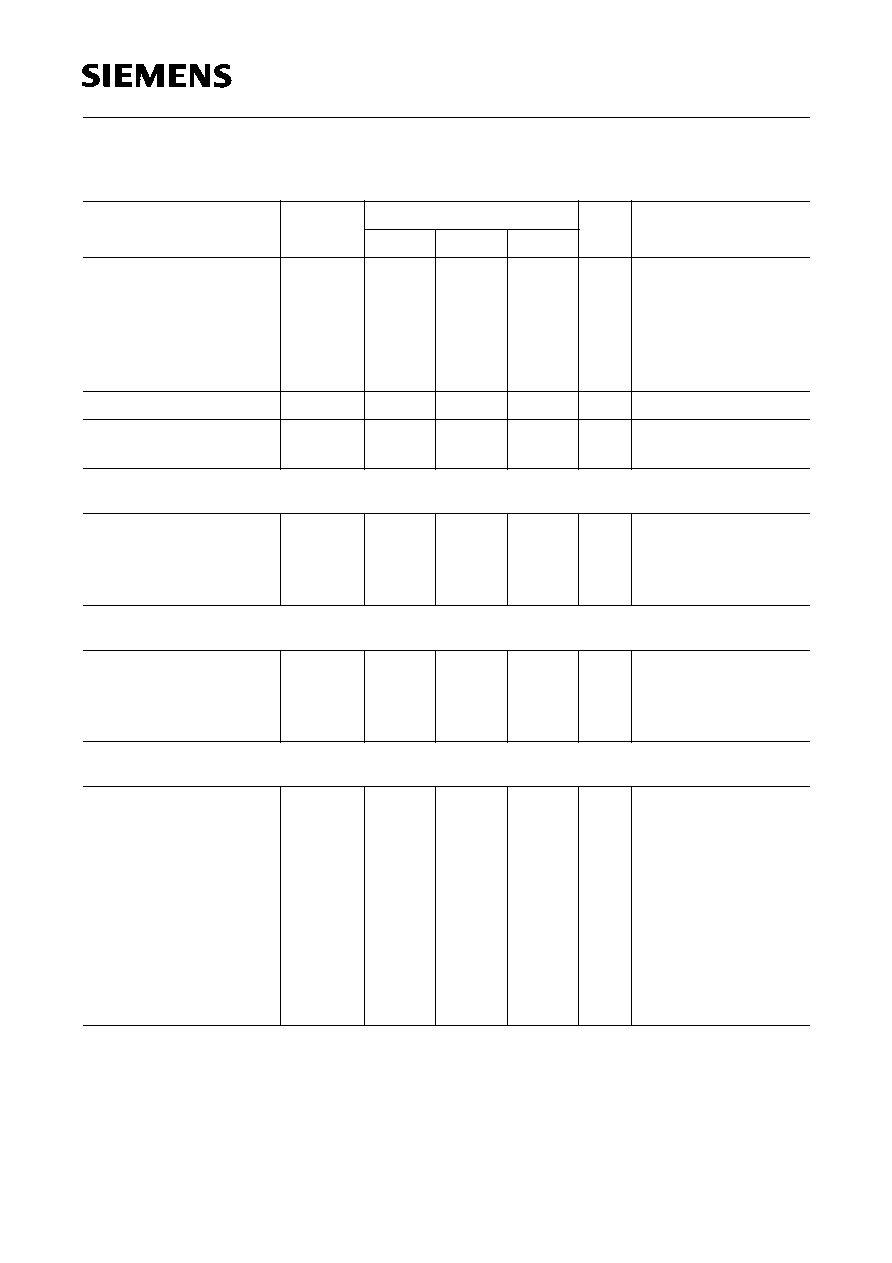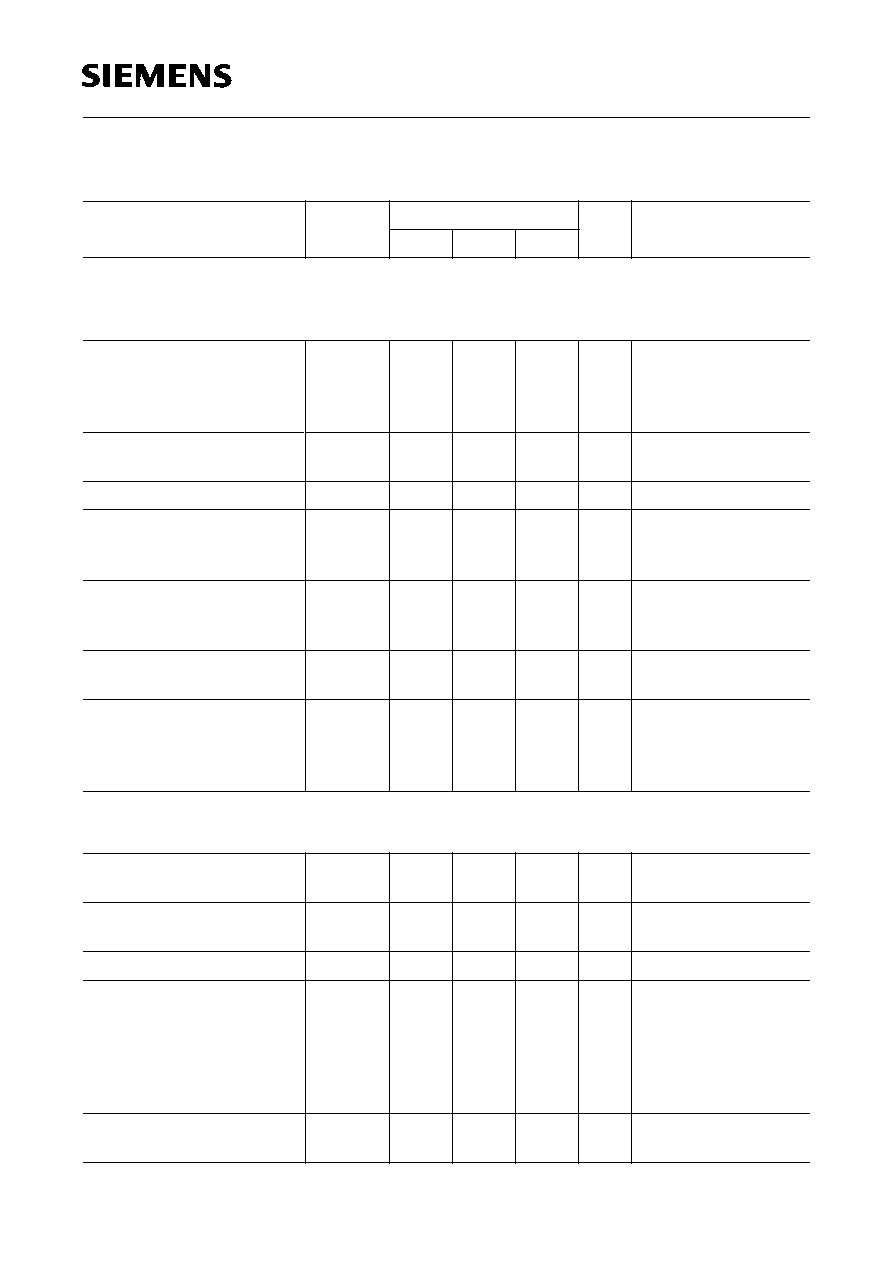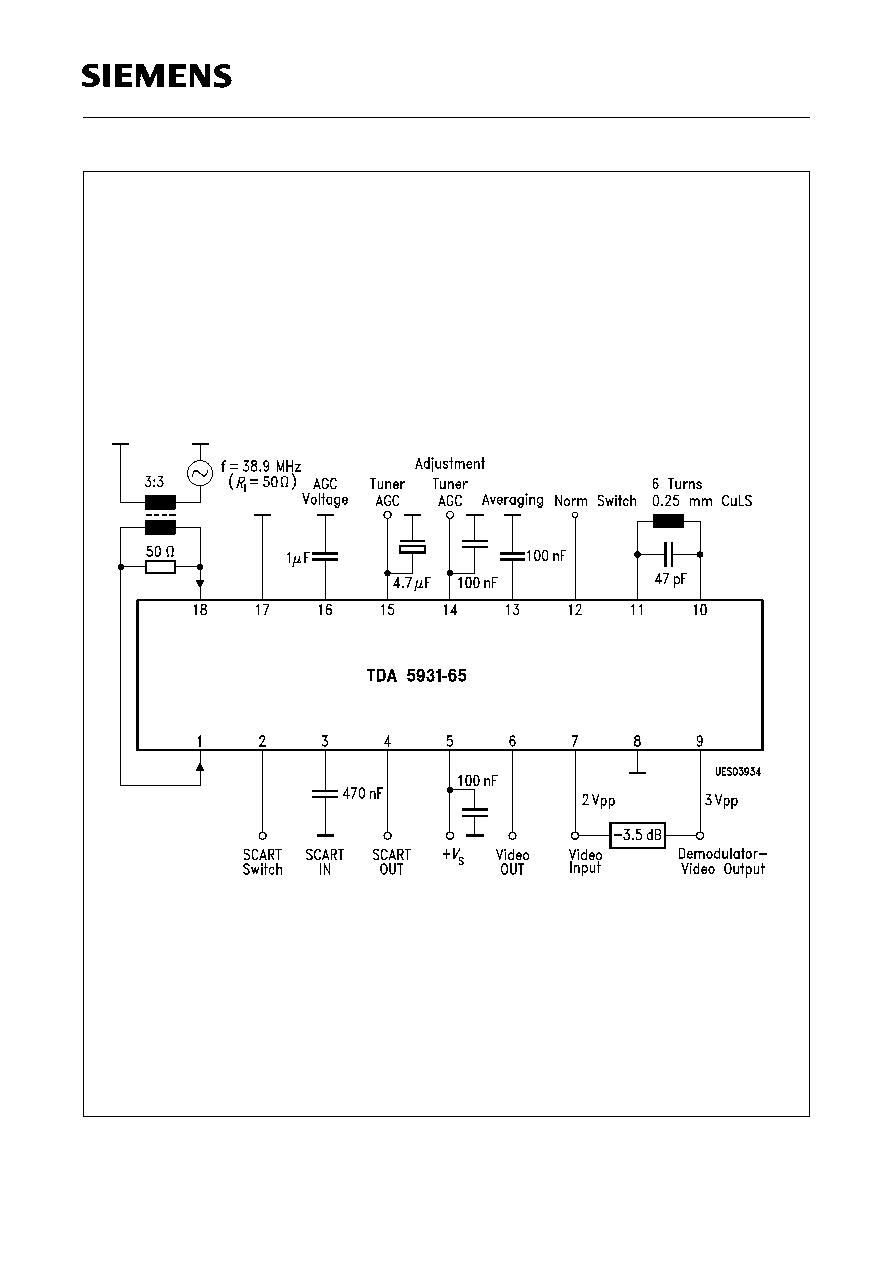
Functional Description
Video IF for all European standards for positive and negative modulation. The video section
contains a Full-SCART interface. An output for the demodulated video signal (pin 9) allows the
insertion of a sound trap into the signal path to the input or the SCART switch and the SCART output
buffer amplifier (pin 7). The analog setting function (delayed AGC threshold) is controlled via a
potentiometer, all other switch functions are controlled via open-collector transistors.
Circuit Description
The component includes a four-stage, capacitively coupled, symmetrically designed and controlled
amplifier, a limiter with selection, and a mixer for quasi-synchronous demodulation of positive and
negative modulated IF signals. In addition a video output amplifier and noise suppression circuitry
are included. This output is used for generating the AGC voltage. The AGC for both modulation
types has been realized as integral AGC with noise free peak and mean value detector (only for
positive modulation). For SCART applications this output is switched a video source switch with two
inputs (for the demodulator signal or SCART socket) and two outputs (SCART- and TV output). The
demodulator output (pin 9) provides a video signal output level 3 dB higher than the level required
for the operation of the TV set or to drive the SCART connector. Therefore it is possible to insert a
sound trap in between this output and the input of the SCART switch (pin 7). The insertion loss of
the sound trap has to attenuate the signal level at pin 9 by a factor 2/3 or 3 dB (AC and DC) to avoid
distortions in the SCART switch.
The delayed tuner AGC is generated by a threshold amplifier driven by the control voltage. The
amplifier response can be controlled by means of an external potentiometer. (The increase of the
tuner AGC voltage shall create a higher tuner gain = positive control).
Type
Ordering Code
Package
TDA 5931-65
Q67000-A5136
P-DIP-18
Video IF Amplifier and Demodulator
with Full-SCART
Bipolar IC
TDA 5931-65
P-DIP-18
Features
q
Multistandard video IF
q
Interference suppression circuitry
q
Mean/peak value control
q
Area of application: TV set with Full-SCART
Semiconductor Group
31
06.94

Semiconductor Group
32
TDA 5931-65
Pin Functions
Pin No.
Function
1
Video IF input
2
SCART switch A/W
3
SCART input
4
SCART input/output
5
+
V
S
supply voltage
6
Positive video output
7
Video output of the sound trap (2 Vpp)
8
Ground
9
Video input of the sound trap (3 Vpp)
10
Demodulator tank circuit
11
Demodulator tank circuit
12
TV-standard switch-over (B/G) � (L)
13
Low-pass filter (averaging)
14
Tuner AGC threshold
15
Tuner AGC output
16
AGC-time constant
17
Ground
18
Video IF input

Semiconductor Group
33
TDA 5931-65
Block Diagram

Semiconductor Group
34
TDA 5931-65
Absolute Maximum Ratings
T
A
= 0 to 70
�
C
All voltage values are referenced to ground, if not stated otherwise.
The current are identified according to the source/sink principle. If the
I
C
considered a sink (the
current flows from the respective pin to ground), it is identified by a negative algebraic sign.
However, if the
I
C
is the source (the current flows from
V
B
via the respective pin to ground), it is
identified by a positive algebraic sign.
Parameter
Symbol
Limit Values
Unit
min.
max.
Sound trap input
V
7
3.3
8.5
V
Demodulator output
V
9
0
V
5
V
Demodulator output
I
9
� 3
10
mA
Supply voltage
V
5
0
13.2
V
SCART A/W
V
2
0
6
V
Pos. video output
I
6
� 3
5
mA
Pos. video output
V
6
0
8.5
V
Demodulator tank circuit
V
10
/V
11
0
V
5
V
SCART OUT
I
4
� 3
5
mA
SCART OUT
V
4
0
V
5
V
Tuner AGC threshold
V
14
0
6
V
Tuner AGC output
V
15
0
10
V
IF input
V
1
/V
18
0
6
V
IF control
V
16
0
8.5
V
Norm switch-over
V
12
0
6
V
Norm switch-over
V
13
0
6
V
SCART IN
V
3
0
6
V
Junction temperature
T
j
150
�C
Storage temperature
T
stg
� 40
125
�C
Thermal resistance (system-air)
T
th SA
70
K/W
Operating Range
Supply voltage
V
5
10.8
13.2
V
Supply voltage delayed tuner AGC
V
15
1.5
13.2
V
Ambient temperature during operation
T
A
0
70
�C
Input frequency range � 3 dB
f
IF
10
100
MHz
Input frequency range � 0.3 dB
f
IF
30
75
MHz

Semiconductor Group
35
TDA 5931-65
Characteristics
T
A
= 25 �C;
V
S
= 12 V
The characteristics data apply to the supply voltage range
V
S
stated or in case of alignment to the
alignment instructions (see page 40). All static voltages are referenced to ground if not stated
otherwise.
The input levels are given as rms values referenced to synchronous peak
f
PC
= 38.9 MHz.
Parameter
Symbol
Limit Values
Unit
Test Condition
min.
typ.
max.
Static Characteristics
Total current consumption
�
I
5
38.5
56
71.5
mA
V
1/16
= 10 mVrms
AGC Voltage
Min. AGC
Max. AGC
V
16
V
16
0
2.6
0.1
2.85
0.5
6.0
V
V
V
1/16
= 45
�
Vrms
V
1/16
= 175 mVrms
AGC-Time Constant (by neg. modulation)
Charge current (
I
max
:2)
Discharge current
Charge/discharge ratio
I
16
�
I
16
V
16
0.55
13
55
0.7
17
82
0.95
23
140
mA
�
A
V
16
= 2 V;
V
6
< 2.2 V
V
16
= 2 V;
V
6
> 2.8 V
AGC-Time Constant (by pos. modulation)
Charge current
Discharge current
Discharge current
Charge/discharge ratio
I
16
�
I
16
�
I
16
V
16
1.1
0.15
70
4000
1.4
0.25
90
5600
1.7
0.35
110
9000
mA
�
A
�
A
V
16
= 2 V;
V
6
4.1 V
V
16
= 2 V;
3.1 V <
V
6
< 4.1 V
V
16
= 2 V;
V
6
< 2.3 V
Averaging by Pos. Modulation
White level
V
13
4.9
5.7
6.5
V
V
1/18
= 10 mVrms
Zero carrier level
V
13
3.3
3.7
4.1
V
V
1/18
= 0 V;
V
16
= 3 V
Tuner AGC threshold
I
5
=
I
max
:2
V
14
I
14
V
16
V
16
4.2
650
2.8
0.33
4.5
850
3.1
0.38
4.8
1050
3.4
0.43
V
�
A
V
V
R
14/17
=
V
14
= 0 V
R
14/17
= 10 k
R
14/17
= 10

Semiconductor Group
36
TDA 5931-65
Characteristics (cont'd)
Parameter
Symbol
Limit Values
Unit
Test Condition
min.
typ.
max.
Tuner AGC current
max. 1 ms
�
I
15
�
I
15
10
0
18
�
30
10
mA
�
A
V
15
= 0.5 V
5
V
1/18
= 100 mVrms
V
14
= 0.75 V
V
15
= 0.5 V
5
V
1/18
= 10 mVrms
V
14
= 4.0 V
IF input
V
1
,
V
18
5.7
6.0
6.3
V
Demodulator tank
V
10
,
V
11
V
5
�
3.5
V
5
�
3.8
V
5
�
4.1
V
Video Output (Demodulator)
Output current
Output current
Sychron level
�
I
9
I
9
V
9
1.9
4
5.2
2.6
5.6
3.3
6.2
mA
mA
V
V
9
= 6 V,
V
1, 18
=
carrier no-demod.
to ground
V
1/18
= 10 mVrms
Sound Trap Input
Sychron pulse level
White level
V
7
V
7
3.3
3.7
5.7
6.0
V
V
Signal ratio
V
9/7
= 3/2
Signal ratio
V
9/7
= 3/2
V
1/18
= 0 V;
V
16
= 3 V
0 V >
V
2
> 2.4 V
Pos. Video Output
Output current
Pos. modulation
(L standard)
White level
Zero carrier (sync.)
Neg. modulation
(BG standard)
Synchron pulse level
Zero carrier
� I
6
I
6
V
6
V
6
V
6
V
6
1.7
4
3.9
1.9
1.9
4.1
2.2
4.2
2.2
2.2
4.4
2.7
4.9
2.7
2.7
5.1
mA
mA
V
V
V
V
V
6
= 6 V
to ground via
R
= 500
see Sound Trap
Input
V
1/18
= 10 mVrms
V
1/18
= 0 V;
V
16
= 3 V
V
1/18
= 10 mVrms
V
1/18
= 0 V;
V
16
= 3 V

Semiconductor Group
37
TDA 5931-65
Characteristics (cont'd)
Parameter
Symbol
Limit Values
Unit
Test Condition
min.
typ.
max.
Neg. SCART Output
Output current
Pos. modulation
(L standard)
White level
Zero carrier (sync.)
Neg. modulation
(BG standard)
Synchron pulse level
Zero carrier
� I
4
I
4
V
4
V
4
V
4
V
4
1.6
4
V
5
� 5.3
V
5
� 3.2
V
5
� 3.2
V
5
� 5.5
2
V
5
� 5.0
V
5
� 2.9
V
5
� 2.9
V
5
� 5.2
2.6
V
5
� 4.3
V
5
� 2.5
V
5
� 2.5
V
5
� 4.6
mA
mA
V
V
V
V
R
L
=
; see Sound
Trap Input
V
4
=
V
5
to ground via
R
= 500
V
1/18
= 10 mVrms
V
1/18
= 0 V;
V
16
= 3 V
V
1/18
= 10 mVrms
V
1/18
= 0 V;
V
16
= 3 V
Pos. SCART Input 4
Clamp level
Output current
V
3
I
3
1.8
3
1.9
2
V
mA
via
R
= 270 k
at
ground
V
3
= 1.2 V
Switching Voltage
L = L/E standard
H = B/G standard
o. open
V
12
V
12
0
2.4
1.9
6
V
V
Switching Voltage
Open = SCART operat.
H = SCART operation
L = HF operation
V
2
V
2
V
2
2.4
0
6
1.9
V
V
Dynamic Characteristics
Min. IF-input voltage
start of internal
AGC operation
f
PC
rms
V
1/18
45
60
�
V
6 Vpp � 1 dB
Max. IF-input voltage
(end of internal
AGC-control range)
f
PC
rms
V
1/18
105
140
mV
6 Vpp � 1 dB
IF-control range
v
65
70
dB

Semiconductor Group
38
TDA 5931-65
Characteristics (cont'd)
Parameter
Symbol
Limit Values
Unit
Test Condition
min.
typ.
max.
Video output voltages (peak to peak)
f
PC
= 10 mVrms with neg. modulation and
residual carrier = 10%; with neg. modulation and residual carrier < 6%
Pos. video output
changes related to
TV-standard switch over
V
6
V
6
1.8
2.0
2
2.2
5
Vpp
%
0 V <
V
2
< 1.9 V
0 V <
V
12
< 1.9 V;
0 <
V
2
< 1.9 V
2.4 V <
V
12
< 6 V
Change due to operating
voltage
1.5
3
%
V
6
/
V
5
10.8 V <
V
5
< 13.2 V
Neg. SCART output
V
4
1.9
2.1
2.3
Vpp
R
L
=
Changes of the video output
voltage over the control
range of 55 dB
V
6
0.2
0.5
dB
Video gain
V
6
/
V
3
1.9
2.0
2.1
R
G
< 500
;
2.4 <
V
2
< 6 V;
V
3
= 1 Vpp (2 MHz)
Video bandwidth
P
6/3-3dB
8
9
MHz
2.4 <
V
2
< 6 V;
V
3
= 1 Vpp sinus
Cross talk attenuation
A
40
50
dB
0 <
V
2
< 1.9 V;
V
1/18
= 0 V;
V
16
= 3 V;
V
3
= 1 Vpp sinus
50 Hz ... 10 MHz
Design Notes (no 100% final test)
Input resistance
(symmetrical)
R
1/18
1.5
2
2.5
k
Input capacitance
(symmetrical)
C
1/18
2
5
pF
Low pass cut-off
f
� 3 dB (13)
70
100
130
Hz
C
13/17
= 100 nF
�
10%
Pos. video output
white level
Synchron pulse level
frequency
V
6
V
6
3.9
1.9
4.2
2.2
4.9
2.7
V
V
2.4 <
V
2
= 6 V
;
(SCART operation)
V
3
= 1 Vpp norm
video signal
V
3
= 1 Vpp norm
video signal
Video input voltage
�
3 dB at
R
G
< 500
V
3
1
Vpp

Semiconductor Group
39
TDA 5931-65
Characteristics (cont'd)
Parameter
Symbol
Limit Values
Unit
Test Condition
min.
typ.
max.
Intercarrier noise voltages ratio (weighted according CCIR 468) with parallel tank circuit 38.9 MHz,
SAW 361 D,
f
TT
= 5.5 MHz (� 13 dB), demod.: TBA 120
FuBk � test picture
FuBk � test picture
S/N
S/N
�
S/N
�
S/N
2
48
17
11
dB
dB
dB
dB
V
1/18
= 10 mVpp
FuBk mod.
V
1/18
= 10 mVpp
2.753 MHZ mod.
with detuning
f
= � 400 kHz
with detuning
f
= + 400 kHz
Dyn. Output Resistance
Pos. video output
Neg. video output
R
6
R
4
80
100
115
150
150
200
Noise figure
V
1/18
= � 57 dBm =
+ 50 dB
�
V
R
G
= 800
F
5
7
dB
Video noise voltage ratio at
BT
= 10 mVrms
0 dB = 700 mVrms BA
unweighted
weighted according to
CCIR Rec. 567-1
S/N
S/N
50
55
55
60
dB
dB
Video Frequency Response
� 3 dB
� 12 dB
B
3 dB
B
� 12 dB
8
15
10
17
13
20
MHz
MHz
Residual Carrier Voltage at Video Output
f
PC
= 10 mVr ms 38.9 MHz
Fundamental wave
1. harmonic wave
f
= 77.8 MHz
V
6
V
6
3.0
0.3
6.0
0.6
mV
mV

Semiconductor Group
40
TDA 5931-65
Characteristics (cont'd)
Parameter
Symbol
Limit Values
Unit
Test Condition
min.
typ.
max.
Differential Gain with
f
PC
= 10 mV (staircase signal)
Peak to Peak According to CCIR Rec. 567-1
Staircase signal
Changes via AGC
Changes via detuning
f
PC
= 38.9 MHz;
f
�
400 kHz
DG
DG /
v
DG /
f
4.5
6
�
1
�
1.5
%
%
%
Differential Phase with
f
PC
= 10 mVrms (staircase signal)
Peak to Peak According to CCIR Rec. 567-1
Staircase signal
Changes via AGC
Changes via detuning
f
PC
= 38.9 MHz;
f
�
400 kHz
DP
DP /
v
DP /
f
2
2.5
1
�
1
degree
degree
degree
Interdemodulation Ratio
With
f
IM
= 1.07 MHz =
f
TT
�
f
FT
With
BT
= 10 mVeff
With sound porch � 13 dB
With sound porch � 13 dB
With sound porch � 13 dB
a
IM
a
IM
a
IM
32
54
51
38
60
57
�
�
�
dB
dB
dB
OFW G 3950
OFW 361D
OFW G 1956
Demodulator Tank Circuit Voltage
f
PC
= 38.9 MHz;
C
= 47 pF
L
= 350 nH
100
Q
0
120;
Q
8
60;
B
0.8 ... 1.0 MHz
V
10/11
300
450
600
mVpp
Synchron pulse
V
Sync
/V
6
5
%

Semiconductor Group
41
TDA 5931-65
Alignment Instructions
At a video carrier input level of
V
1/18
= 4 mVrms,
f
PC
= 38.9 MHz and a superimposed AGC voltage
of
V
16
= 1.5 V the tank circuit is aligned that way, that at the positive video output the demodulated
video signal 6 Vpp is at its maximum.
As a modulation every sufficient video test pattern can be used. Then the superimposed AGC-
control voltage at pin 16 is reduced until the video signal has an amplitude of approx. 2 Vpp. The
video signal is then fine tuned for its maximum.
The adjustment is not critical due to the wide maximum.
The adjustment can also be performed regarding intercarrier signal to noise ratio, differential gain or
2T-pulse response.

Semiconductor Group
42
TDA 5931-65
Test Circuit

Semiconductor Group
43
TDA 5931-65
Application Circuit












